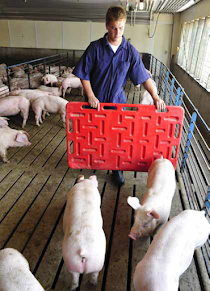Handling swine can be a bit of an adventure to a first time pig owner and even a bit challenging for those who have raised pigs for several years. Unlike cattle, pigs cannot be easily worked in alleys and chutes. Even goats and sheep can be controlled by hand easier than a pig. Learning to use a few simple tools can make swine handling easier and most of all safe for pigs and people.
Moving pigs is usually the first task to learn how to perform and can be done easily using some basic tools. First is using a swine board or sometimes called a sorting board. A swine board is made to be tall enough a pig cannot see over it and wide enough to match at least half of a mature pig's body length. It can be made of wood metal or plastic. Swine boards are used as a portable wall. When moving pigs out of a pen or in an alley way, a swine board visibly blocks off a path of travel for a pig. If the pen or alley is wider than one swine board can block adding another person with a swine board is best.
It is best to use the swine board to do one of two things. Swine boards can be carried behind a pig or group of pigs to encourage them to move away from the board and in the direction you want them to travel. Boards can also be used to help stop or turn a pig. By placing a swine board across an alley just past a turn, a pig will naturally walk toward the board, see their path is blocked and usually make the turn you want them to take.
 |
| Photo Credit: pork.org |
Other tools include a paddle, flag, cane or driving stick. These are similar to a show stick and are used to drive a pig in a direction by either blocking their direction of travel or lightly tapping on the opposite side of the body from the direction you want them to travel. As they learn about these items they can then be used as a visual cue and just placing the item in the pig's vision will cue them to turn away from it and travel in the direction you want them to go.
When it comes time to restrain a pig to give an injection, draw blood for a vet check, or ear tagging, there are few options. The easiest method is using a snout snare. A snout snare can be either a commercially purchased item or can be homemade. A snout snare works when a pig opens their mouth slightly and the snare is placed around the upper jaw and snout. When it is pulled snug, a pig cannot back out of it and can be secured for tagging, giving an injection or other veterinary procedure.
At first look, a snout snare appears to be restricting the pigs ability to breath out of their nose. A properly placed snout snare fits under the upper jaw and over the nasal bone and does not block off any of the pigs nose or nasal passages allowing them to breath normally.
 |
| Photo Credit: Virginia Tech, OUV |


No comments:
Post a Comment